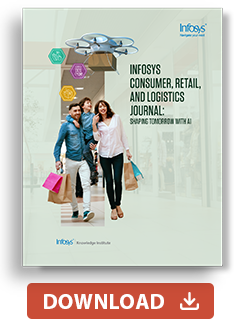
Insights
- In a tough market, businesses are using AI-driven revenue growth management strategies to drive sales while aligning with customer needs and market trends.
- To remain relevant, they need to reimagine shopper engagement, embrace digital technologies, and deliver seamless, cross-channel shopping experiences.
- Brands can combine expertise, analytics, and technology to proactively managing and reducing shrinkage.
- As agentic AI advances, its capacity to autonomously coordinate and execute complex tasks for businesses will keep growing.
Foreword
Welcome to our 2025 Consumer, Retail, and Logistics Journal.
Over the past few years, we have witnessed an incredible and interdependent revolution in the technology landscape across semiconductors, data technology, and artificial intelligence (AI) technology.
This revolution is led by AI and machine learning, which in the coming years holds the promise of significant leaps in human productivity compared to the revolutions of the past 100 years.
But AI is not merely an enhancement to existing processes, systems, and people. It is a catalyst for renaissance and renewal. It requires businesses to critically examine enterprise performance on the five fundamental vectors of time, space, physical capital, human capital, and throughput.
They must also shift focus from talent mass to talent density, mastering enterprise datasets to become AI-ready. And all in a manner that widens the competitive moat of the business, while giving tangible improvements in business metrics that matter.
In this journal, we share our view of a few multimodal AI capabilities in different parts of the value chain in consumer, retail, and logistics industries that have matured in terms of adoption and value realization.
These views reflect partnerships between Infosys and select technology leaders in servicing the AI-led renaissance with some of our strategic clients in the consumer, retail and logistics industries. We will keep bringing out at regular intervals new innovations that have scaled in adoption and step-change improvements in value realizations.
The path ahead is one of change, evolution, and positive transformation, and I am optimistic that together we can make a difference, and shape a better future for the generations to come.
Executive summary
The consumer packaged goods (CPG), retail, and logistics industries are evolving quickly, driven by technological advancements and digital innovations to boost efficiency and customer satisfaction. However, with consumer demands and technology constantly shifting, the industries need to keep on top of those factors and be ready to adapt quickly to remain competitive.
This journal highlights six transformative trends reshaping these industries. Each chapter examines the current landscape, identifying challenges and complexities within business and technology trends. Drawing on research, case studies, and real-world applications, the journal offers recommendations to equip leaders in CPG, retail, and logistics with a comprehensive understanding of their industry, explore ways to address their pain points, and make decisions informed by the latest thinking.
We first look at revenue growth management strategies, with a focus on AI. With consumer spending patterns sensitive to external factors such as inflation, CPGs need to be nimble in their pricing strategies, and it’s here that RGM solutions, powered by AI, can help. These strategies can aid CPG companies in building capabilities to assess brand pricing, improve revenue predictability, and drive steady growth.
Next, we look at the eternal problem of shrinkage, and at how next-generation retailers are using AI for faster, more accurate data-driven insights in managing shrink across the enterprise, warehouse, and store levels.
We explore how this end-to-end visibility into their processes in real time can help them pinpoint areas where shrinkage is causing losses, and address their issues accordingly.
We also look at how the lines between physical stores and digital stores are blurring, with retailers aiming to provide a seamless and consistent shopping experience whether their customers are in a store, at home on a laptop, or out and about using a mobile phone. We consider the range of technologies available to retailers, from cutting-edge AI to augmented reality (AR), and how retailers can deploy those technologies across all channels to attract, engage, and retain their customers.
We next turn our attention to how CPG companies need to look at their infrastructure and get it ready to deliver those seamless shopping experiences consumers expect. Many companies still rely on inflexible, monolithic systems that make it difficult to integrate new technologies. We explore how adopting a MACH architecture — Microservices, API-first, Cloud-native, and Headless — can help businesses add new technologies seamlessly, embedding flexibility and resilience, and providing a platform on which to innovate.
Underpinning much of what we cover in this journal is AI, a ground-breaking technology that is driving transformation across all sectors. However, companies need to make sure they have the building blocks of governance, technology, talent, data, and strategy in place. In this chapter we look at how CPG companies must recognize that AI is becoming a general-purpose technology to be embedded across the enterprise technology stack. Adopting an AI-first mindset moves companies toward enterprise AI readiness, whether it’s ensuring they have a valid use case, select those that will deliver substantial business value, or build talent in AI.
Finally, we turn to the coming wave of AI: Agentic AI, and the role this technology can play in CPG companies. AI agents are fully autonomous systems that pursue specific goals with minimal human oversight. With their ability to dynamically engage, solve complex problems, and learn in real time, agentic AI offers exciting potential to CPG companies across a range of use cases.
Keeping a close watch on these trends and being ready to act on the insights in this journal will help CPG, retail, and logistics leaders navigate the evolving business and technology landscape. By embracing AI-driven innovation, digital transformation, and adaptable architectures, organizations can enhance operational efficiency, drive growth, and thrive in an increasingly dynamic and complex market.

Trend 1: AI-powered revenue growth management delivers accurate insights
The importance of RGM
Consumer packaged goods (CPG) companies make the everyday products that global customers cherish. Research from Infosys shows that global retail sales grew by 10% in 2023 — but that’s partly because companies raised their prices. Inflation is expected to stay above the pre-pandemic average of 2.7%, so continuing to increase their prices can be a risky strategy for companies. In different markets, household budgets are getting tighter.
For example, retail sales growth in China slowed in November 2024 to just 3% year over year, while in India consumers are cutting spending as inflation squeezes middle-class budgets. In the UK, households cut back on purchases by as much as 15%, between 2021 and 2023, while in the US, consumers are turning to store brands over well-known brands.
In this challenging environment, retailers are deploying revenue growth management (RGM) strategies to help boost revenue while staying in tune with what customers want and what’s happening in the market. When used together, strategies like price, packaging, where products are sold, and promotions can protect market share and keep revenues growing sustainably.
Traditional RGM is fractured
The RGM process is important, but it’s fragmented across the organization. Many CPG companies still use outdated methods with incomplete data, which means they don’t get the insights they need. To get a full view, businesses need both internal and external data, such as what consumers are buying, how strong their brand is, and what competitors are doing. To thrive in today’s fast-moving environment, CPG leaders need faster, clearer insights to make better pricing decisions.
Adopting AI-powered RGM
RGM solutions, powered by artificial intelligence (AI), can help CPG companies build the capabilities to assess brand pricing, improve revenue predictability, and drive steady growth.
For example, Infosys worked with a British consumer company to use analytics for comparing its detergent prices with those of competitors. The company found that its Detergent A’s pricing was doing well, with a small lead over a competitor, so no price change was made. In contrast, Detergent B’s pricing was behind, so the company changed its price to be more competitive.
With machine learning (ML), CPG companies can use simulations to test pricing scenarios and check revenue effects. Based on ML model outputs, managers can then decide whether to make changes in real life across regions, channels, and retail stores.
Strategic RGM approaches
As AI continues to evolve, CPG companies might benefit from considering these best practices for thoughtful preparation and implementation.
Ensure data readiness
Recent research from Infosys shows that only 17% of companies believe their data is ready for AI. For an AI-powered RGM platform to deliver transformative results, companies need trusted data from every part of the business. This means both structured and unstructured data should be collected, cleaned, labeled, and stored securely in one place for seamless access. The value of this data is even clearer when it is shown in AI-powered dashboards.
For example, imagine a global CPG company using an AI-powered platform to discover that an e-commerce product page had a 77% drop in ad spending. The AI suggests increasing the ad spend and estimates a dollar amount. So, what would be the result for the company? AI-powered dashboards can turn complicated data into easy-to-understand insights and clear actions to take.
Unlock RGM with integration
Looking at price, price pack, channel, and promotions together gives a clear picture for setting the most optimal prices that align with brand equity. CPG companies can realize strategic objectives by using AI to identify RGM opportunities, such as:
- Strategic pricing matches consumer expectations with the company’s market share.
- Price-pack architecture finds gaps in pack pricing to win more customers and gain market share.
- Channel assortment chooses the best mix of products for each channel, selecting from the company’s full range of products.
- Trade promotion measures return on investment and boosts effectiveness for future promotions.
When companies combine all parts of RGM, they can grow market share, increase profits, and build stronger channel partnerships. For example, Infosys worked with an Italian multinational food company to use RGM analytics to improve pricing, promotions, and expansion plans. The company uncovered between $70 million and $100 million in incremental annual free cash flow.
Make the right pricing decisions
The standard elasticity model has long been key for setting tactical pricing and promotion strategies, but today’s competitive market demands more. Brands are now using AI-driven RGM tools to go beyond old pricing models. They can simulate strategic pricing decisions, like figuring out the Strategic Price Index (SPI) compared to competitors, and design a better promotion plan. With AI-driven RGM tools, CPG companies can factor in:
- Consumer behavior analysis to learn how people react to promotions, product placements, and online shopping.
- Brand equity alignment to combine brand tracker insights with data about different groups of people, matching pricing with market share goals.
- Competitor intelligence to gain insights from econometric models with benchmarks and syndicated data.
Optimize price-pack structures
For price-pack architecture, AI models can analyze the relationship between price points and product packaging for different sizes or bundle offerings. The goal is to meet consumer needs and maximize profitability. For example, AI tools can run simulations to identify the most effective ways to offer products in various sizes, packaging, or bundles.
CPG companies can serve different customer groups, such as price-sensitive, value-driven customers, while driving incremental sales. AI can with reasonable accuracy identify strategic pricing and packaging combinations. This helps reinforce brand equity and makes products stand out in competitive markets.
Ensure the right product mix
For channel and mix assortment, AI models can help CPG companies target the most profitable customer groups and reduce inefficiencies. For example, AI can run simulations to align products with how customers shop online, in convenience stores, or at big-box stores. Shelf space can be maximized by picking the best items for shelves — especially popular or high-profit ones — to boost sales and make products easier to find. This way, CPG companies can simplify their product mixes and better meet what customers want.
Evaluate past promotions
CPG companies have valuable historical data about trade promotions. Using analytics, managers can look back at previous promotions to see what worked best. They can then use these insights to recommend more effective promotions in the future. This type of data-driven planning can help businesses get better returns on their trade investments.
With predictive analytics, managers can also look ahead. AI/ML can predict how future promotions, like discounts during slow times, might work. This capability helps brands plan more strategically and spend their budgets on promotions that are likely to drive the highest returns, while phasing out underperforming initiatives.
RGM is transformational
AI-driven revenue growth management is a game-changer. It helps CPG leaders make faster, smarter decisions with precision. By reducing risks in pricing, assortment, and promotions, companies unlock new profit streams. These profits can fuel research and development, spark innovation, and elevate products to the next level. RGM isn’t just a tool — it’s a strategic advantage that drives sustained revenue growth and keeps brands ahead of the competition.
Revenue growth management solutions, powered by artificial intelligence, can help CPG companies build the capabilities to assess brand pricing, improve revenue predictability, and drive steady growth.

Trend 2: AI solutions help manage retail shrink across the organization
Social and economic impact
Retail loss and shrinkage have reached an unprecedented volume across regions. More individuals, whether customers or employees, are resorting to retail theft and fraud to counter high inflation. In the UK, theft from stores reached an all-time high of more than 20 million incidents in 2023-24, costing retailers £2.2 billion ($2.8 billion), up from £1.8 billion the previous year, according to the British Retail Consortium. In the US, the National Retail Federation reported that theft accounted for $112 billion in losses in 2022. Theft accounts for 66% of retail shrink, impacting sales revenues.
When people think about retail shrinkage, they often picture shoplifting or payment fraud. But not all shrinkage comes from crime. Many retailers incur losses from operational issues such as damaged goods during handling, inventory tracking errors, or warehouse mis-picks.
The US National Retail Federation found in 2022 that 26% of shrink comes from administrative process failures and poor controls. Retailers manage vast supply chains, multiple partners, and complex inventory systems, and they often lack real-time, end-to-end visibility into these processes. Another 8% of shrink is classified as “unknown loss,” highlighting the blind spots that exist across the enterprise, warehouse, and store levels.
Using AI to reduce shrink
Next-generation retailers are now turning to artificial intelligence (AI) for faster, more accurate, data-driven insights. While retailers have long relied on traditional loss prevention methods — such as closed-circuit TV (CCTV) cameras and electronic article surveillance tags — AI solutions can help identify shrink across the enterprise, warehouse, and store levels.
How to manage shrink
Enterprise level
Many organizations struggle with AI readiness to manage shrink. Recent research by Infosys found that only 15% of respondents expressed confidence in having the necessary elements for successful AI projects, including a business case, clear use cases, and governance approval. Yet a well-defined AI strategy is essential to building the data infrastructure needed for AI-powered loss prevention.
For example, AI-enabled dashboards act as a control center that provides visualized, real-time updates. AI monitoring can detect anomalies, track discrepancies, and alert users to these issues. Drawing from large language models (LLMs), generative AI solutions can suggest insights and recommend responses for loss prevention teams.
Enterprise data can also be leveraged for different types of machine learning (ML) modeling. For example, unsupervised ML can scan network traffic for unusual activity and flag suspicious events. Looking ahead with predictive analytics, reinforcement learning and model simulations can forecast the areas most at risk for future losses.
Warehouse level
Warehouses and distribution centers use CCTV cameras and inventory management systems to prevent losses, creating volumes of data. But raw data alone isn’t enough. AI and advanced analytics make it possible to process data faster and with greater accuracy, turning existing security investments into sharper tools. Take computer vision, for example — a form of AI that helps machines interpret images and videos. Applied to security footage, it can detect suspicious behavior in real time, giving loss prevention managers the chance to act before theft occurs.
These facilities are highly restricted areas, and they are beehives of activity with equipment operators, pickers, packers, and third-party logistics providers in constant motion. Drones and robotics add another layer of control, conducting product quality inspections to identify spoilage, mishandling, or improper storage before they cause losses. Meanwhile, loss prevention experts tap into access control data from biometric scanners and keycards, using analytics to pinpoint weak spots and prevent unauthorized entry.
Store level
As public spaces, stores face the widest variety of theft and fraud scenarios, involving customers, employees, and vendors. Sometimes, multiple parties collude. For example, one person might distract employees while an organized crime group steals merchandise. Employees might also work with vendors or delivery drivers to steal inventory in exchange for money or goods. Advanced analytics can help store leaders with labor scheduling and task management. In large stores, they can better identify where employees are stationed, such as at registers, on the sales floor, or in stockrooms.
- Point of sale (POS) fraud
Cashier fraud, often called sweethearting, happens when employees give unauthorized discounts or free items to friends, family, or coworkers. Common methods include not scanning products, overriding the price, and processing fake refunds.
To get ahead of this type of fraud, Infosys worked with a leading footwear and apparel manufacturer to reduce POS fraud using AI. By applying quantitative and behavioral analysis, the AI identified patterns on POS transactions. Some 5,000 suspicious cases were flagged to the loss prevention team, reducing potential fraud by 20% and saving approximately $8 million in revenue. - E-commerce fraud
Online shopping surged during the Covid-19 pandemic, and criminals have become more advanced and more organized to exploit return policies and shipping gaps. Common fraud techniques include fake refunding services and “missing in transit” scams that manipulate return labels.
Infosys helped a client use AI-powered analytics to detect $500,000 in potential return fraud. The AI revealed that 80% of suspected fraudsters were first-time buyers with similar shopping and return patterns, leading the company to place 239 customers on a restricted list.
People play a role
Reducing shrink isn’t just about AI — it also depends on employees. Online training programs and process enhancements can teach them the best ways to handle difficult situations. Without training, a cashier might unintentionally commit fraud, such as approving a refund without a receipt to calm an upset customer. While this might seem minor, it can impact a company’s bottom line.
A global sportswear manufacturer found that 23% of in-store cash refunds lacked original receipts in a specific region. Infosys helped the company use AI analytics to monitor key performance indicators and store-level trends. Within a month, the AI solution helped the company identify the potential loss of revenue, helping prevent further shrink.
The way ahead
With the right mix of expertise, analytics, and technology, retailers can shift from preventing losses to actively managing and minimizing shrink. The key is to stay focused on what matters — protecting revenue, safeguarding brand reputation, and preserving customer trust. AI and advanced analytics are catalysts for faster, data-driven decisions. Shrink is a reality today, but with an AI-powered strategy, it doesn’t have to define the future.
While retailers have long relied on traditional loss prevention methods — such as CCTV cameras and electronic article surveillance tags — AI solutions can help identify shrink across the enterprise, warehouse, and store levels.

Trend 3: Consumers bring online expectations into physical stores
Shaped by online experiences
Physical stores offer more than just transactions — they create ambience, encourage discovery, and provide spaces for social connection.
The desire for in-person experiences is reflected in retail trends. Forecasts predict that physical stores will account for almost 80% of global retail sales in 2025. Some brands are expanding aggressively, such as an Irish fashion retailer that is planning to reach 530 stores by 2026, and an Indian kitchen appliance maker is aiming to grow its store count by 30% over the next four years.
At the same time, other brands are closing stores. In 2024, a French supermarket group closed 768 stores, while an Australian pizza chain shut down 205 stores.
This contrast shows the influence of e-commerce on the physical environment. Customers continue to define shopping experiences — bringing their online expectations of highly customized, contextualized, and personalized shopping with them into bricks-and-mortar stores. To stay relevant, retailers must rethink how they engage shoppers, introduce digital technologies, and create easy shopping experiences across channels.
Innovation meets fixed limits
Consumer trends and expectations change quickly, forcing retailers to keep innovating for competitiveness. But bricks-and-mortar stores have real-world constraints — fixed layouts, high real estate costs, and logistical challenges — that limit how quickly they can adapt. Conversely, digital platforms can update their algorithms, interfaces, and personalized recommendations instantly and in response to customer needs.
Elevate the experience
Retailers are using artificial intelligence (AI) to improve the store shopping experience. For example, a US food and drug retailer introduced AI-powered shopping carts; and a European beauty retailer installed interactive mirrors for customers to virtually try on makeup before buying. These innovations help physical stores increase revenues, stand out from competitors, and make in-person shopping not just an alternative to online shopping, but the preferred customer experience.
Digital solutions for stores
Retailers need to innovate quickly to boost sales in the short term while staying flexible for long-term success. Recent research from Infosys shows that companies are starting to measure the impact of AI. Among respondents, 47% see value as the main measure of success for AI projects, 36% focus on the number of AI projects, and 17% prioritize the speed of project delivery.
To keep up with changing trends and enhance the store experience, retailers can use a range of digital technologies to attract, engage, and retain customers.
Sales and marketing
Retailers are turning to generative AI to craft marketing campaigns that draw customers into stores. By analyzing shopping habits and trends, generative AI tools can create content such as advertisements, emails,
and social media posts designed to drive foot traffic. Global fast-food chains, for example, are using generative AI to create eye-popping campaigns that appeal to their customers.
Back at the corporate office, marketers use data analytics to measure how many people click on adverts, and to monitor customer sentiment on social media. This real-time analysis allows them to adjust messaging on the fly, making sure their marketing stays effective across all platforms.
Customer attraction
Many stores are surrounded by other businesses, creating a steady flow of foot traffic. Geofencing and beacons help retailers capture these potential customers.
Geofencing has been around since the 1990s, using GPS, Wi-Fi, or cellular data to set virtual boundaries over larger areas, like cities and neighborhoods. Major retailers, such as Sephora and Walmart, use this technology to target customers when they enter a specific zone.
Beacons, on the other hand, rely on Bluetooth to send signals within short distances, like inside a store. Apple’s iBeacon, launched in 2013, helped popularize the technology. Target, for example, built beacons into its LED lighting to guide shoppers to products. McDonald’s sends coupons to opted-in customers when they’re nearby.
Once a customer is attracted to come inside, AI-powered apps can offer them personalized deals and shopping assistance, making the in-store experience more engaging.
Luxury touches
Luxury retailers are now embracing blockchain, joining financial services and tech companies in the technology’s many uses. For brands built on white-glove service, this digital record system helps high-end clientele ensure that every purchase is verifiable.
Blockchain technology offers an unbreakable chain of verification and can be used to prove ownership and prevent stolen luxury goods from circulating. For example, Swiss watchmaker Breitling uses blockchain to track its timepieces, giving owners instant access to product history and proof of authenticity. As another example, London-based De Beers registers its diamonds on a blockchain, allowing buyers to scan and verify a stone’s origin and quality at every stage.
Smarter inventory
Making sure the right products are available at the right time is key to maximizing sales. But managing inventory across multiple locations can be a challenge.
The world’s largest sportswear brand encountered a dilemma during Covid-19: Some stores had too much stock, while others ran out of popular items. To solve this, Infosys partnered with the company to build a global partner exchange. This platform allowed stores to fulfill orders from any location, even if they didn’t have the product on hand. This real-time inventory system made 27,000 products available, processed 750,000 orders in a single day, and shipped 100,000 items within a week. At the end of the day, the company fulfilled a key customer service mission to help customers get what they want, when they want it.
Basket size
A fundamental goal in retailing is to maximize each customer visit by encouraging larger purchases. Retailers design their strategies around pricing, promotions, product placement, and checkout experiences to encourage customers to leave with more than a single item.
One growing approach is the endless aisle, which lets customers browse a store’s full inventory online while shopping in person. If an item is out of stock, they can scan QR codes on the product’s empty shelf to order it for home delivery or pickup. Store associates walk the store floor with tablets to help customers check inventory and arrange purchases on the spot.
Digital kiosks are another tool helping retailers capture more sales. Found in many quick-service restaurants, kiosks allow customers to place and customize orders at their own pace, reducing wait times and improving efficiency.
By integrating these digital solutions, retailers can provide an easy, flexible shopping experience — helping customers find what they need while driving higher sales.
Customer loyalty
Loyalty programs are more than just rewards — they provide valuable data on shopping habits, preferences, and engagement. This insight allows retailers to personalize experiences, strengthen relationships, and drive repeat business. Beyond rewards, a frictionless shopping experience also builds loyalty. Self-checkout, contactless payments, and no-checkout technology make in-store visits as smooth as online shopping. When customers trust a brand to provide convenience, they’re more likely to return.
For example, a major US department store, known for hosting iconic American events, is enhancing its ticketing and user experience platform. By extending engagement beyond a single annual event, the retailer creates a year-round connection with customers. This gives store associates more opportunities to engage with customers, strengthening brand loyalty and increasing in-store visits.
The future of retail
Retail is evolving as technology reshapes store experiences and customer expectations. Once seen as a threat, digital solutions now enhance in-store shopping, making it more engaging and efficient. Success lies in blending online and offline experiences, creating a seamless journey that keeps customers coming back to stores.
Loyalty programs are more than just rewards — they provide valuable data on shopping habits, preferences, and engagement. This insight allows retailers to personalize experiences, strengthen relationships, and drive repeat business.

Trend 4: MACH flexibility helps enterprises navigate constant disruption
Many consumer packaged goods (CPG) companies and retailers operate across multiple countries, managing complex commerce needs in different markets. To stay competitive, they use a mix of old and new technology. Many have added digital commerce platforms on top of their existing enterprise systems to improve flexibility and reduce costs.
But new challenges keep emerging. Supply chain disruptions, inflation, and changing regulations make operations harder. At the same time, online shopping is growing fast, and customers expect better experiences. They want personalized recommendations, up-to-date inventory, and the ability to shop anytime, anywhere. Companies that can’t keep up risk higher costs and losing customers to more agile competitors.
To stay profitable — and set themselves up for long-term success — businesses need to be flexible. They must adapt quickly as the market shifts. This is where MACH (Microservices, API-first, Cloud-native, and Headless) architecture helps. Unlike older, rigid systems, MACH makes it easier to add new technologies, improve efficiency, and stay ready for the future.
Limitations of legacy systems
Many companies still rely on legacy systems — older technologies deployed before the rise of modern digital commerce. For businesses looking to grow, legacy systems can hold them back. Scaling becomes difficult, especially when expanding into new regions with unique regulations. Many older platforms also lack the flexibility to adjust to changing business needs or support long-term customer growth.
These systems are often monolithic, built as one large, interconnected structure. While this design made sense in the past, it now creates challenges. Updating one part of the system often requires changes to the entire structure, making modernization slow and expensive. Despite these limitations, monolithic systems remain common. In a digital commerce study, 55% of respondents reported using monolithic systems, while 25% have built custom digital commerce platforms.
Another challenge is integrating legacy systems with modern applications. This makes it harder for companies to adopt new technologies, such as artificial intelligence (AI) and advanced analytics. The rigid design of older monolithic systems also limits support for the digital touchpoints that consumers prefer, such as mobile apps, voice assistants, and AI-powered chatbots. As a result, businesses struggle to expand their digital capabilities.
Lastly, the issue of technical debt is a persistent challenge across industries. Outdated software accumulates over time, and becomes more expensive to maintain and increasingly vulnerable to cyberthreats due to missing security updates. Many enterprise systems run on old programming languages, such as COBOL, making maintenance even harder as the number of skilled professionals declines.
Adopt MACH architecture
MACH architecture provides a modern approach to enterprise technology. Instead of relying on one large, inflexible system, MACH breaks applications into modular, independent services. This modular design gives businesses the core building blocks to create adaptable systems and speed up the development of custom solutions.
Go modular with microservices
Microservices are individual pieces of business functionality that are independently developed, deployed, and managed. This approach allows for greater flexibility and scalability, as each service can be updated or replaced without affecting the entire system.
Infosys worked with a women’s casual apparel retailer to migrate from its monolithic system to a MACH architecture, with the aim of being more flexible and fully responsive e-commerce sites to engage millennials. To improve that engagement, the retailer wanted to better support omnichannel experiences for their customers and be more agile in business operations. By moving to MACH, the retailer reduced its total cost of ownership by 30%, and achieved a faster go-to-market campaign strategy and higher customer satisfaction.
Put APIs at the core
Application programming interfaces (APIs) are the primary means of communication between components. An API-first approach involves designing and building APIs to ensure consistent and reusable interfaces. This methodology emphasizes creating APIs from the outset, allowing different services to interact seamlessly and promoting flexibility within the system.
A multinational automotive manufacturer wanted a digital platform to support its first European online car sales campaign. The solution needed to offer customers the flexibility to preorder and customize limited-edition cars — in their local language and currency. Infosys worked with the automotive company to fully integrate a composable back-end solution with MACH architecture, including product information management, inventory, cart, and checkout.
As a result, the automotive manufacturer successfully launched a pilot preorder campaign within just 12 weeks. Building on this quick win, the platform expanded swiftly, reaching eight localized European markets within six months.
Scale smart in the cloud
Cloud-native refers to software as a service (SaaS) that uses the cloud beyond just storage and hosting. It can refer to any public cloud platform, such as AWS, Azure, or Google Cloud, or a custom private cloud infrastructure. The cloud platform gives the ability to scale and automatically update. This approach ensures that the software is always up-to-date without the need for manual upgrades, reducing maintenance efforts and costs.
A leading mobile phone carrier, serving over 100 million customers, wanted to modernize its rigid, monolithic B2B system. The objective was to establish a flexible foundation capable of supporting a new B2B2C self-service portal.
Infosys partnered with the carrier to gradually implement microservices over 18 months. By adopting an incremental migration, this approach allowed the company to realize essential benefits sooner. The carrier maintained seamless integration with existing systems through deployment on their private AWS cloud. The new self-service portal now supports over 10 million customers and 800,000 B2B accounts, facilitating transactions worth $12 billion annually.
Unlock agility with headless
Headless refers to the decoupling of front-end presentation from back-end logic. This separation allows businesses to deliver consistent content across various channels and devices, enhancing flexibility and user experience.
A luxury car manufacturer wanted to set up a digital storefront and direct channel for independent auto shops seeking to purchase spare parts. Infosys collaborated with the manufacturer to deliver an end-to-end, headless B2B commerce solution and storefront. This solution used microservices for inventory management, order processing, and cart and checkout functionalities. The implementation helped the carmaker reduce its service level agreements from two days to eight hours. Manual processes were eliminated, and the company achieved 100% transparency with orders, stock availability, cancellations, and refunds.
Embrace MACH for growth
Today’s business world is changing quickly. To succeed, companies must stay flexible and adapt fast. MACH architecture helps businesses overcome the limits of older, all-in-one systems. It allows them to create modern, flexible apps that respond easily to new customer needs.
With its four foundational pillars, MACH is emerging as the go-to architectural approach for companies seeking to stay ahead of the curve. A recent study shows the growing interest in MACH adoption: 46% in the UK, 36% in the US, and 25% in Germany plan to use it more.
By choosing MACH, CPG companies and retailers can break free from vendor lock-ins, reduce infrastructure overhead, and focus on building capabilities rather than managing hosting needs. In times when speed, adaptability, and innovation define market leaders, MACH architecture serves as a strategic enabler for long-term digital success.
The technology to make customers happier and more satisfied exists and, in many cases, is available today. There are no longer any excuses not to adopt it.
Infosys helped a retailer migrate from its monolithic system to a MACH architecture to make its e-commerce sites more flexible and responsive. By moving to MACH, the retailer reduced its total cost of ownership by 30%, and achieved faster go-to-market and higher customer satisfaction.

Trend 5: Use AI to drive transformation and collaboration
The AI race is on
Artificial intelligence (AI) has become more than just a technological breakthrough — it’s now a global battleground. Businesses, products, and even nations are racing to lead the AI revolution, often blurring the lines between corporate innovation and national strategy. The first six weeks of 2025 alone saw seismic shifts in the AI landscape. In January, the US unveiled the Stargate Project, an initiative to invest up to $500 billion in AI infrastructure by 2029. Just one week later, DeepSeek, a Chinese AI company, made headlines by launching a chatbot that rivals leading US models at a fraction of the cost.
This momentum is a stark contrast to just two years ago when Infosys noted a slower rollout of generative AI in the Asia-Pacific (APAC) region. Yet within just two months of its commercial release, DeepSeek catapulted to the number two spot among the top 50 generative AI products worldwide.
Looking further back, France’s AI ambitions have also evolved dramatically. In 2021, the country pledged €2.2 billion ($2.3 billion) toward AI development by 2025 — a figure that now seems modest. Fast forward to February 2025, when at the AI Action Summit in the Grand Palais, France announced a €109 billion investment to accelerate AI infrastructure and deployment projects.
AI deployment challenges
Despite the growing enthusiasm for AI, many organizations today operate as AI-augmented businesses, where humans handle daily tasks and use AI tools to achieve higher rates of productivity. However, many companies are languishing in this transitional state because AI deployment presents hurdles, such as prioritization. Large multinational organizations often identify hundreds of potential AI applications but struggle to determine which initiatives will deliver the most tangible business value.
Infosys research found that only 12% of respondents were confident in their business case validation, and 13% claimed to have a clear use case. Even when high-value AI opportunities are identified, companies often lack a central framework to scale AI in the business. Without a centralized system, AI adoption is fragmented, limiting its impact.
Another barrier is infrastructure. Traditional IT platforms were not designed for AI at scale. Deploying AI successfully requires a purpose-built AI platform that supports speed, scalability, and efficiency. For instance, generative AI and large language models (LLMs) hold exciting potential. Infosys research finds that 55% of Asia-Pacific companies are already creating business value from their generative AI initiatives, compared to 46% of North American and 42% of European companies.
As AI technology advances, the case for deploying it becomes increasingly compelling. Model costs are declining, making AI more affordable and accessible. AI is also becoming more accurate; it can generate outputs that align with user input. And AI’s expanding context window allows it to process more information at once, such as summarizing the key findings of a long research report.
With these advancements unfolding rapidly, organizations must now prepare for the next evolution: Becoming an AI-first business. Leaders will need to embed AI into every process, decision, and function. To thrive in this new era, companies must overcome deployment challenges and establish a clear AI strategy.
Get the AI strategy right
To remain competitive, companies must be ready to embed AI throughout their lines of business, products, services, and daily work. Organizations must recognize that AI is becoming a general-purpose technology to be embedded across the enterprise technology stack. Adopting an AI-first mindset requires companies to take proactive steps toward enterprise AI readiness.
Set up a strong data backbone
AI models are only as good as the data they process. High-quality, enriched data is essential for AI to generate accurate and reliable outputs. This requires:
- Collecting both structured and unstructured data from across the enterprise.
- Cleansing and labeling data to ensure consistency and relevance.
- Storing data securely in a centralized repository for seamless access.
As AI models expand — some can handle up to 2 million tokens — companies can process vast amounts of data. But without quality control, AI-generated insights could be flawed or biased. Organizations must invest in robust data governance to maintain accuracy and integrity.
Adopt a value chain perspective
Evaluating AI in isolation through standalone use cases can often make it difficult to justify its impact. Instead, businesses should take a holistic view of the value chain to identify opportunities where AI can automate processes and eliminate inefficiencies — because that’s where value is realized.
For example, in logistics, AI can streamline the entire value chain. AI-powered customer service speeds up booking, improving turnaround times. Dynamic pricing maximizes revenue, while AI-driven route planning, labor scheduling, and customs compliance lower costs and minimize errors. In a complex industry of languages, regulations, and paperwork, AI can enhance efficiency, empowering employees to move materials and goods faster.
Train and equip employees
Beyond a technology revolution, AI is driving a talent transformation. Deploying AI across all levels of the company requires a thoughtful change management and enhanced training. Personalized AI coaches can help employees build skills in areas like prompt engineering, while generative AI can create more on-demand courses faster to keep up with the pace of rapid AI developments. The goal is to provide employees with the right knowledge and the confidence to put AI to use in their daily work.
Successful AI deployment demands more than just new technology. It requires a shift in how companies approach talent development and workforce transformation. Employees need to be equipped with the skills to use AI effectively. This includes training in prompt engineering, AI-assisted decision-making, and workflow integration. In North America, 41% of companies plan to close the generative AI skills gap with upskilling and reskilling, compared to 26% who will focus on recruiting talent with generative AI skills.
Generative AI itself can play a role in training by creating adaptive, on-demand learning experiences. Personalized AI-driven coaching can help employees build confidence in using AI.
Get the ethics right
AI must be responsible by design, with ethical principles built in from the start. This means managing data properly, ensuring security, and meeting compliance standards. It also requires guardrails –– guidelines that keep AI fair, transparent, and accountable. Prioritizing these elements early leads to AI that is scalable, secure, and ethical.
What’s next: Human plus AI
As businesses transition from AI-augmented to AI-first models, we will move toward a new paradigm: Human plus AI collaboration. This future state envisions AI agents working alongside human employees to drive efficiency, innovation, and strategic growth.
Indeed, agentic AI will reshape workflows. AI agents are autonomous systems that can sense, engage, act, and learn to achieve specific goals. As AI advances, routine and repetitive tasks will be eliminated, even those that AI tools currently assist with. Humans will remain in the equation to provide judgment, creativity, and oversight. But overall, the promise of agentic AI is to free up human talent for higher-value work, driving innovation.
Successful AI deployment demands more than just new technology. It requires a shift in how companies approach talent development and workforce transformation. Employees need to be equipped with the skills to use AI effectively.

Trend 6: The rise of AI agents that are smart, proactive, and autonomous
The shift to autonomous AI
For decades, artificial intelligence (AI) has operated behind the scenes in many organizations. AI has been used for simulation models and predictive analytics to process data and identify patterns. More recently, generative AI has surged into the spotlight, impressing businesses and consumers with its ability to generate text, images, and code. Yet most AI systems remain reactive — waiting for human input before taking action. That’s about to change.
Agentic AI represents a shift toward fully autonomous systems that pursue specific goals without constant human oversight. These AI agents can engage, act, and learn dynamically, whether working independently, collaborating with humans, or coordinating with other agents. This evolution could transform business operations. In fact, Gartner named agentic AI as the number one strategic technology trend to watch in 2025.
Understanding agentic AI
Agentic AI merges traditional automation with the advanced capabilities of large language models (LLMs) — the same technology that powers generative AI. However, unlike conventional AI systems that rely on human prompts, agentic AI operates autonomously. It can interpret context, make decisions, take action, and continuously refine its approach through learning. This shift enables AI agents to handle complex workflows, optimize operations, and enhance user interactions in ways that go beyond simple automation.
While AI agents are still in the early stages — many are in pilot testing — their potential is immense. A defining characteristic of agentic AI is its capacity for self-improvement.
These agents can monitor their own performance, detect inefficiencies, and adjust their strategies without human intervention. Some systems leverage reinforcement learning, in which they fine-tune their behavior based on trial and error, improving over time.
Beyond self-improvement, agentic AI excels at adaptive decision-making. Unlike traditional automation, which follows predefined rules, these systems can adjust their strategies in response to new data, shifting business goals, or unexpected obstacles.
This ability to analyze changing conditions and refine its approach in real time makes agentic AI particularly valuable in dynamic environments such as supply chain logistics and e-commerce customer service.
LLMs enable AI understanding
The University of California, Berkeley explains that incorporating LLMs into specialized components of AI systems — called cognitive modules, which are responsible for functions like language processing, reasoning, and knowledge representation — enables these systems to understand, generate, and logically process human language. This integration, they note, is what helps AI exhibit true agentic-ness, or the ability to act autonomously and intelligently.
Agents in collaboration
Agentic AI systems can communicate and collaborate without direct human involvement. These agents not only interact with each other, but can also engage with external tools and application programming interfaces (APIs) to retrieve information and real-world tasks. For example, instead of simply finding a nearby pizza restaurant, an AI agent can actually place the order, coordinate delivery, and track its progress — all autonomously.
The next step in agentic AI is scaling these capabilities. The goal is to design agents that with minimal initial instructions can break down complex objectives into a series of interdependent tasks. This is akin to having a digital employee — one who can be assigned broad goals such as closing a sale, and then determine the necessary steps to achieve that goal.
Currently, AI agents can handle multistep processes involving 10 or 15 discrete actions, but this is only the beginning. Future systems could involve hundreds of agents managing different tasks in parallel. These agents wouldn’t just follow rigid commands, they would interpret high-level objectives like a manager giving loose instructions. They might research a topic, select the right software tools, access external data sources, write and test code, develop analytical models, and produce a final report that meets regulatory requirements.
The foundation for this multiagent collaboration is already in place. With advances in data modeling, network structures, and AI-driven reasoning, scalable agentic systems are on the horizon.
Generative AI in action
Agentic AI is already transforming industries by enhancing both developer workflows and business operations. Here’s how AI-driven agents are automating complex tasks, optimizing workflows, and unlocking new efficiencies.
Smarter, faster software engineering
Code generation from natural language
AI-powered coding assistants, such as GitHub Copilot, enable developers to generate functional code from natural language prompts. Microsoft reported that more than 77,000 organizations adopted GitHub Copilot within two years of its release, demonstrating its impact on software development. By handling routine coding tasks, AI is ushering in a whole new era of web development. Rather than writing boilerplate code, developers are focused on solving higher-level architectural and design challenges.
Automated application development
AI agents streamline the software development life cycle, improving speed and accuracy at scale. By leveraging AI-powered micro-agents, companies can automate tasks such as user interface design, API development, and system integration. In a use case scenario, Infosys estimated that AI-driven development can boost efficiency by between 30% and 50%, reduce time-to-market by up to 15%, and improve quality metrics by up to five times.
AI-powered decision-making
Beyond development, agentic AI empowers business users by automating data retrieval, enhancing search capabilities, and generating high-quality content. Key applications include:
Automated business intelligence
Agentic AI relies on an LLM that can orchestrate the actions of multiple AI agents to quickly pull and analyze business data without the need for coding or database skills. Instead of manually searching for information, users can ask simple questions — like “how many sales did we make last week?”— and the AI will retrieve the answer.
Product and content optimization
AI agents help business users make informed decisions by analyzing and improving product information. They can check labels for compliance with industry standards, generate clear product descriptions, and summarize customer reviews — giving users the insights they need to refine offerings and enhance customer experience.
Knowledge extraction
AI agents help business users quickly find and understand critical information. AI agents retain information about past steps and decisions. This enables them to maintain context and adapt to manage complex, multistep tasks that need contextual awareness. This is unlike traditional AI, which does not carry memory of past interactions and input. For example, Amazon uses AI agents to enhance order processing by improving inventory management and automating warehouse workflows, leading to quicker deliveries.
Instead of manually sifting through lengthy documents, users can rely on AI to generate clear summaries, highlighting the most important details. Additionally, AI can extract business rules embedded in code, transforming complex system logic into structured documentation. This makes it easier for teams to analyze processes, update systems, and ensure compliance.
Smarter search for customers
AI-powered search helps customers find what they need, even if they don’t know the exact words to describe it. Instead of typing rigid keywords, shoppers can use natural language — “Find me a summer dress for a wedding” — and the AI is capable of understanding their intent and emotion. This is unlike traditional AI that is preprogrammed and needs more human intervention. Agentic AI sums up search results from a wide range of sources, condenses them, and shares them. Customers can also search using images rather than text. By analyzing visual content, AI can suggest similar products, making discovery faster and more intuitive.
From streamlining development to automating business intelligence, agentic AI is already delivering measurable impact. As these systems evolve, their ability to coordinate and execute complex tasks autonomously will only continue to expand.
Looking ahead
In 2025-26, AI agents will play a larger role in the workforce, operating with human supervision but driving automation and decision-making. A recent Infosys report highlights the growing adoption of autonomous AI agents, signaling a shift in how businesses approach problem solving.
As businesses embrace agentic AI, ethical and security considerations must also be addressed. Ensuring fairness, reducing bias, and maintaining transparency in AI-driven decisions will be crucial, particularly as these systems gain more autonomy. Organizations must implement safeguards to ensure AI remains aligned with business values and regulatory standards.
Agentic AI is set to redefine automation, offering organizations greater autonomy, adaptability, and efficiency. These systems can handle complex tasks, optimize workflows, and fuel innovation across industries. As AI technology advances, businesses that embrace agentic AI will gain a competitive edge — boosting productivity, streamlining operations, and unlocking new opportunities for growth.






